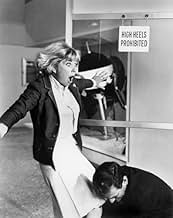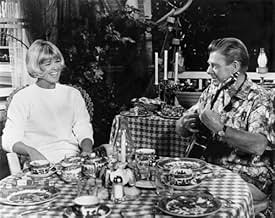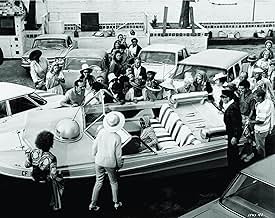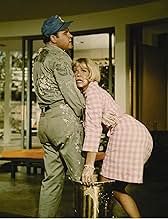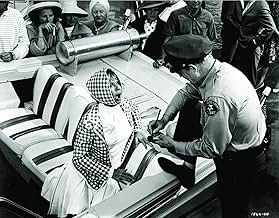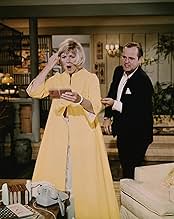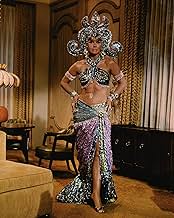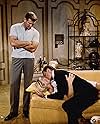Après une série de malentendus, le directeur d'un laboratoire de recherche aérospatiale commence à soupçonner sa nouvelle petite amie d'être une espionne russe.Après une série de malentendus, le directeur d'un laboratoire de recherche aérospatiale commence à soupçonner sa nouvelle petite amie d'être une espionne russe.Après une série de malentendus, le directeur d'un laboratoire de recherche aérospatiale commence à soupçonner sa nouvelle petite amie d'être une espionne russe.
- Récompenses
- 1 nomination au total
- Julius Pritter
- (as Dom De Luise)
- Party Guest
- (non crédité)
- Executive
- (non crédité)
- Party Guest
- (non crédité)
- Party Guest
- (non crédité)
Avis à la une
That might have been bad because this was the best of Doris Day's films in the late sixties as she was beginning a downward drop in her box office appeal. The Glass Bottom Boat was the second film she did with Rod Taylor as co-star and the first of two she did with Frank Tashlin as director. And this one was the best product in both associations.
Doris works in public relations at a space lab in California where scientist Rod Taylor is developing new stuff for the Defense Department and NASA. She also doubles and helps her dad Arthur Godfrey on his glass bottom boat tourist vehicle. One of the things I like best about The Glass Bottom Boat is Doris sings again on screen, once in a nice duet with Arthur Godfrey on his ever present ukulele. She also sings her most famous song, Que Sera Sera once again for a new generations of film fans.
One thing about Doris's later films, she always had excellent supporting casts and this one is loaded with some very funny people like, Edward Andrews, John McGiver, Paul Lynde, Dom DeLuise, Dick Martin, George Tobias, and Alice Pearce. They all fill roles that you would expect from them.
The Glass Bottom Boat has Rod Taylor concerned with plant security in regard to his top secret work. An overzealous security guard played by Paul Lynde overhears Doris call her dog on the phone. What she does is that in order to give the pooch some exercise during the day she calls her own number, counts the rings and then says something to the unanswered phone. It's for the dog to get exercise because he runs around like a maniac when the phone rings.
From that we deduce that Doris is a Soviet spy and the real CIA in the person of Eric Fleming is called in. This was Fleming's last big screen appearance before he was drowned on location in Peru. A very sad end to a career that might have been the equal of his Rawhide co-star, Clint Eastwood.
Seeing Paul Lynde in drag, questioning an inept spy played by Dom DeLuise is worth seeing this film alone.
This film has a wonderful use of color, an admirable pacing and a freshness rarely seen in the studio comedies of the time (the singing scene in the boat looks totally improvised). But if Tashlin's background as a cartoonist often contributes to his creative ability to take situations beyond the edge, and to destroy a stiff established order, very seldom this very quality can work against him. And this is what happens with all the bad guys in this film. They are a mere caricature, and one can never feel them as a serious threat. The theme demanded something more serious, and these clumsy amateurs certainly fail.
Anyway, watch the film and sing the title's tune; it'll remain with you for ages.
I bought the DVD after not seeing the film since that long ago 1966 night--incidentally, I vividly recall the huge waves of laughter from the audience during several scenes; anyone who dismisses this film as a fiasco or whatever obviously didn't experience a very happy crowd seeking some light entertainment. On seeing the DVD, I was impressed by the sharp editing (I'm an editor--believe me, the timing of various sight gags etc. are very well done), creative use of colors and consistently high level of comedic performances. The naysayers who have posted otherwise don't know from squat. Overall, a totally innocuous movie that has retained a nice reputation as a still enjoyable memento of the mid-'6os.
The picture did get a Music Hall premiere run in New York, but as I say, most people just yawned.
Seen forty years later it has a lot going for it, especially compared to today's cinema "comedies": good writing, expert direction, good pacing and editing, colorful location shots of Catalina and vicinity, good playing by the leads, who look to be having fun, and really good support from that amazing cast of 60s character actors.
There is a surprising amount of frank sexuality in this picture for the time, without nudity or profanity (Doris' character is a widow so she plays her as sexually mature and sophisticated), Godfrey's character has a wife/girlfriend about whom he's absolutely crazy and shows it, often (!), and there's even a surprising gay subplot that's played for laughs of course, but not offensively so. There's even Paul Lynde in drag...priceless!
Forty years later, it still makes me laugh. You will too.
Le saviez-vous
- AnecdotesRobert Vaughn: briefly appears in his central role of "Napoleon Solo" from Des agents très spéciaux (1964) at the party, with a snatch of that show's theme music on the soundtrack. The same music is heard when Homer Cripps goes undercover in drag. Theodore Marcuse played three different guest characters on that show. Dom DeLuise appeared on the spin-off The Danish Blue Affair (1966).
- GaffesWires are visible in both scenes set in the NASA anti-gravity chamber; first on the test astronaut, and also when Jennifer accidentally enters the room.
- Citations
Edgar Hill: I want to talk to you a minute. Those phone calls, there is no question about it. She's an agent, operating for the...
Bruce Templeton: She's no more an agent than you are! And if you're the best the CIA can come up with, this country is in big trouble!
Edgar Hill: Now, look here! We'll have to detain her.
Bruce Templeton: Mrs. Nelson can leave here whenever she wishes!
Edgar Hill: What's that noise?
Bruce Templeton: What? Oh, well, I locked her in the closet.
- Crédits fousOpening credits: The events, characters and firms depicted in this photoplay are fictitious. Any similarity to actual persons, living or dead, or to actual firms, is purely coincidental.
- ConnexionsEdited into Rowan & Martin at the Movies (1968)
Meilleurs choix
- How long is The Glass Bottom Boat?Alimenté par Alexa
Détails
- Date de sortie
- Pays d’origine
- Langue
- Aussi connu sous le nom de
- The Glass Bottom Boat
- Lieux de tournage
- Sociétés de production
- Voir plus de crédits d'entreprise sur IMDbPro
Box-office
- Montant brut aux États-Unis et au Canada
- 9 200 000 $US
- Durée
- 1h 50min(110 min)
- Rapport de forme
- 2.35 : 1



